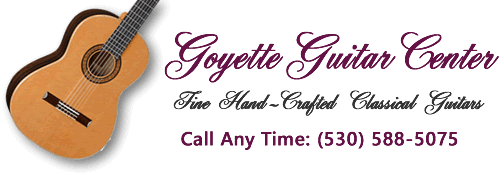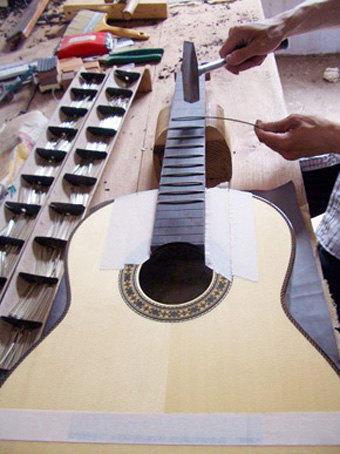Classical guitar fretboards are not normally perfectly straight.
Ideally, they would have a very slight bend to them, called relief. This allows a bit more clearance for the strings, especially the bass strings. If you press one of the bass strings at both ends, at the first fret and the 14th fret, there should be a very small space at the 7th fret between the top of the fret and the bottom of the string, about the thickness of a normal business card, more or less. A small amount of neck relief would minimize fret buzzing for one who plays with a heavy downward stroke. Ideally, the neck should be perfectly straight, or have just a very small amount of relief. What you don’t want is an upward bow, which would require excessively high strings in order to play cleanly. This would make the guitar unnecessarily difficult to play.
Most steel string guitars have adjustable truss rods which are used to adjust the neck relief.
The reason for this is that steel strings exert much more pressure on the neck than nylon strings, requiring periodic adjustment as the neck bows under the pressure. This does not normally happen with Classical guitars, so truss rods are not normally used in classical guitars.
Fret buzz can result from excessively low string height or from uneven frets.
If the buzzing occurs only in certain places, for example, only at the third fret of the low E string, but not at other places on the fret board, then the probable culprit would be a slightly high fret. To test for this, place a straight edge over three frets and see if it rocks slightly, indicating that the middle fret is high. To rectify this, you would need to file the fret down in the offending area, re-crown, and polish it. Repeat this process wherever on the fretboard you experience buzzing.
Some players play with a heavy hand and need to adjust the string height higher than normal.
The normal ideal string height would be about 2.5mm to 3mm for the high E string at the 12th fret and about 3.75mm to 4mm for the low E string at the 12th fret. Measure from the top of the fret to the bottom of the string. For those who play with a heavy hand, the string height would normally be about 3mm for the high E string, and about 4mm to 4.5mm for the low E string.
To change the string height, loosen all the strings completely and, with a needle nose pliers, slide the bridge saddle out and replace it with a higher one.
The bridge saddle is the white piece of bone in the bridge. When you purchase a guitar from the Goyette Guitar Center it is important that you indicate to me your style of play so that I can set up your guitar with the proper string height that would maximize ease of play and prevent fret buzzing.


